Current revocation rates in German patent nullity proceedings
Reported by Prof. Dr. Tilman Müller-Stoy, Dr. Anna Giedke and Julian Große-Ophoff
This article presents the current revocation rates with respect to granted patents in Germany on the basis of the case law of the German Nullity Senates of the German Federal Patent Court and the German Federal Court of Justice in the period between 2018 and 2020. It highlights patents from the field of software and telecommunications. Repeating this survey was prompted by the dispute regarding the presumption of validity of patents in preliminary injunction proceedings which has recently been escalated up to the Court of Justice of the European Union.
After several years, it is time to collect and analyze current data on the revocation rates in German nullity proceedings again.1
At the same time, there is also a specific reason for doing so: Judges are divided on the issue of the presumption of validity of a patent, which has been examined and granted, in preliminary injunction proceedings. According to the current case law of the three leading Higher Regional Courts (Düsseldorf, Karlsruhe and now also Munich), the assumption of validity is increasingly being challenged. In principle (with a few recognized exceptions), a preliminary injunction should only be considered where a patent has already successfully withstood contentious validity proceedings. However, if the validity of the patent has not yet been attacked, such patent is not suitable without more ado as a basis for granting a preliminary injunction. 2 The 21st Civil Chamber (Patent Litigation Chamber) of the Regional Court of Munich I considers this practice to be unlawful as it is irreconcilable with EU law, and it therefore sought clarification from the European Court of Justice.3
This article therefore summarizes the nullity case law of the German Federal Patent Court and the German Federal Court of Justice for the years 2018 2020 and reveals how many patents were revoked for what reasons and to what extent.
A. Tenor of the survey
All published judgments rendered by the German Federal Patent Court and the German Federal Court of Justice in German patent nullity proceedings between 2018 and 2020 inclusive (following on from an earlier survey for the years 2010 to 2013 inclusive) form the basis of the survey.4
The survey first involved examining the judgments of the Nullity Senates5 of the German Federal Patent Court (221 judgments in total6). These were organized according to date, Senate, and operative provisions. In addition, the grounds of the judgments were considered more closely in order to be able to better assess how often the various nullity grounds were successful. Furthermore, a differentiation was made between European and German patents, in order to clarify whether there were any differences in this respect.
Following this, the judgments from the nullity appeal proceedings before the 10th Senate of the German Federal Court of Justice were analyzed for the period between 2018 and 2020 inclusive. This involved a total of 115 judgments.7 These were also examined in accordance with the above criteria. Where the German Federal Court of Justice upheld a decision at first instance, a differentiation was made according to whether the patent was revoked, partially revoked, or maintained. However, amending judgments were categorized according to whether the patent was revoked, partially revoked, partially restored, or maintained or whether the proceedings were referred back to the German Federal Patent Court for a ruling.
Finally, the judgments relating to software and telecommunications patents (S/T patents)8 that are particularly relevant in practice were assessed separately and examined to determine how often lack of patentability as a result of public prior use was claimed and the success rate of these claims.
B. Revocation rates and other figures
I. German Federal Patent Court
1. Overall presentation of the German Federal Patent Court
a. Total figures for 2018-2020
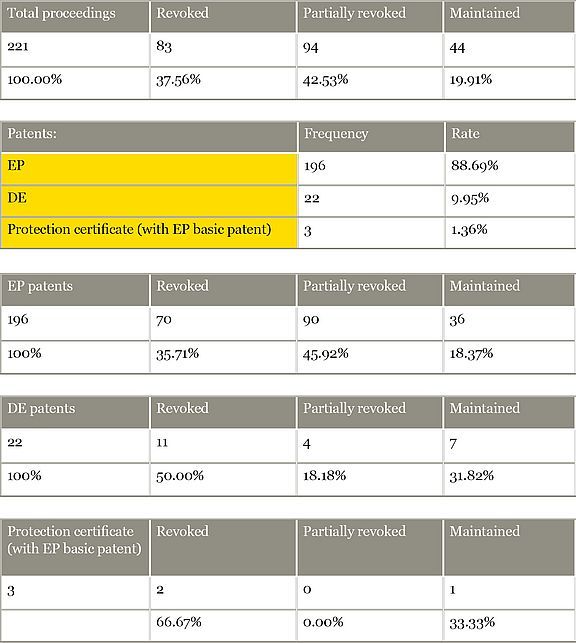
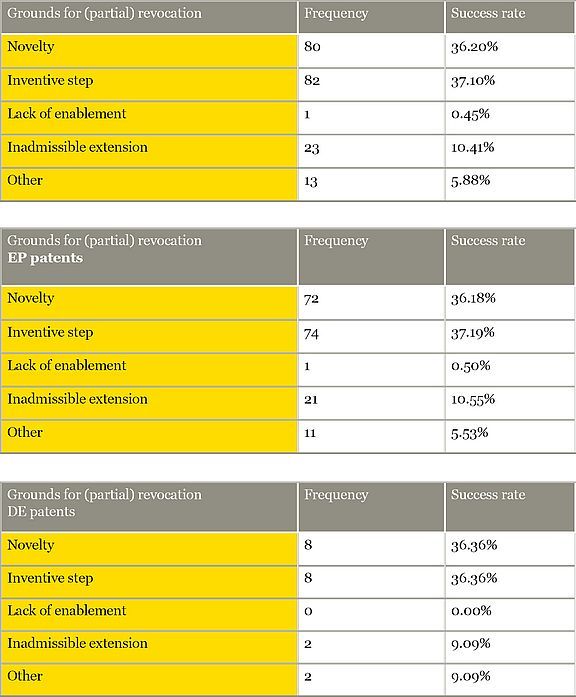
b. Figures relating to S/T patents
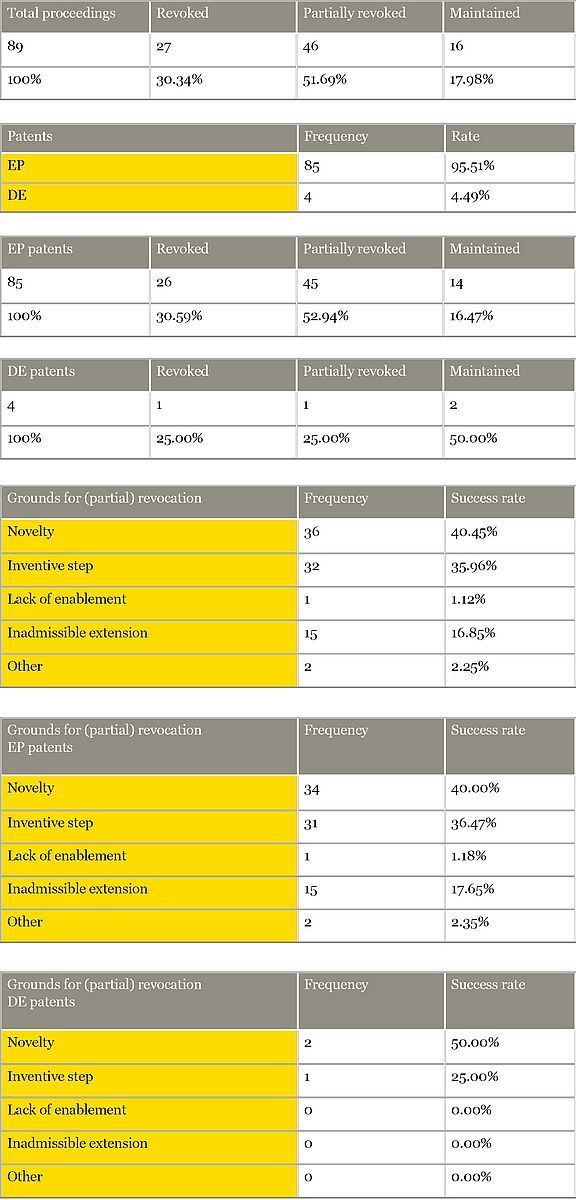
2. Overview of the figures for the individual Senates of the German Federal Patent Court
a. Total proceedings before the German Federal Patent Court

b. Proceedings relating to S/T methods

3. Overview of the figures for the 1st Senate
a. Total figures for 2018-2020
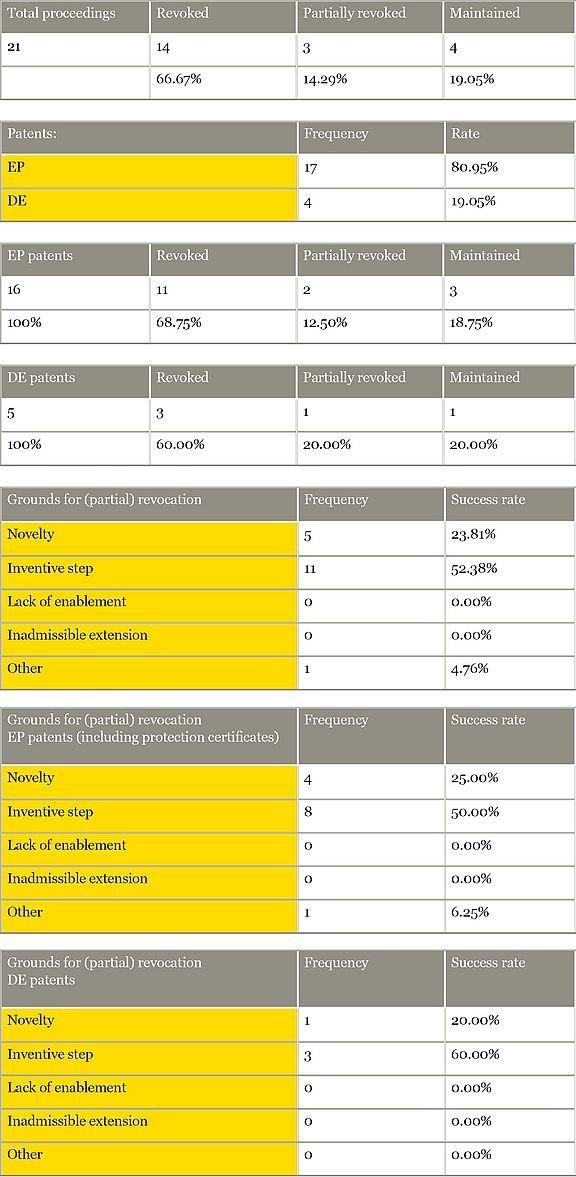
b. Figures relating to S/T patents

4. Overview of the figures for the 2nd Senate
a. Total figures for 2018-2020
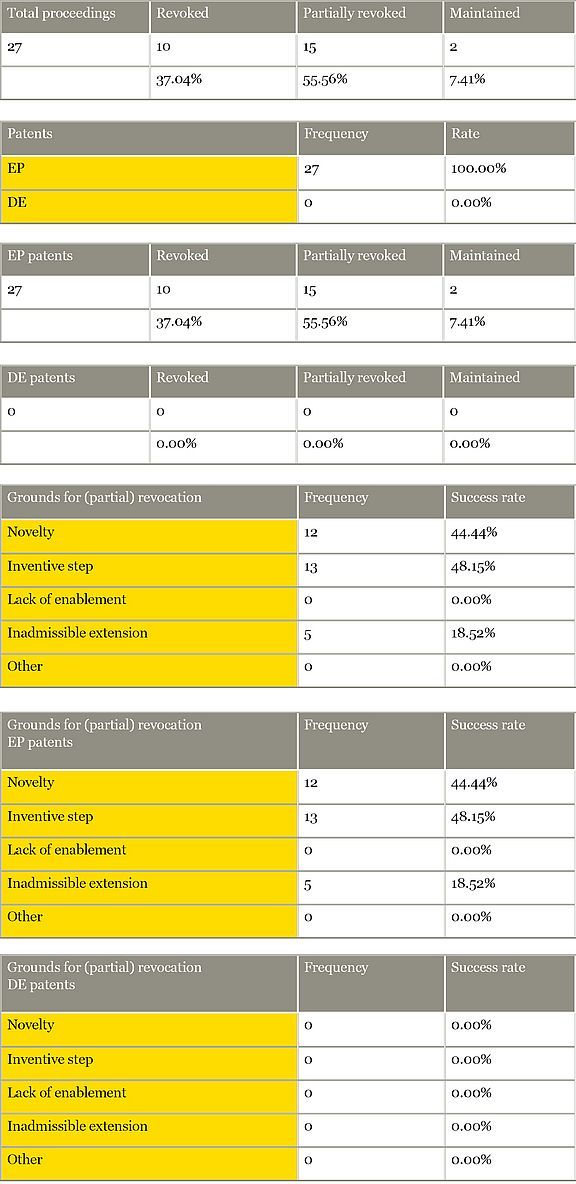
b. Figures relating to S/T patents
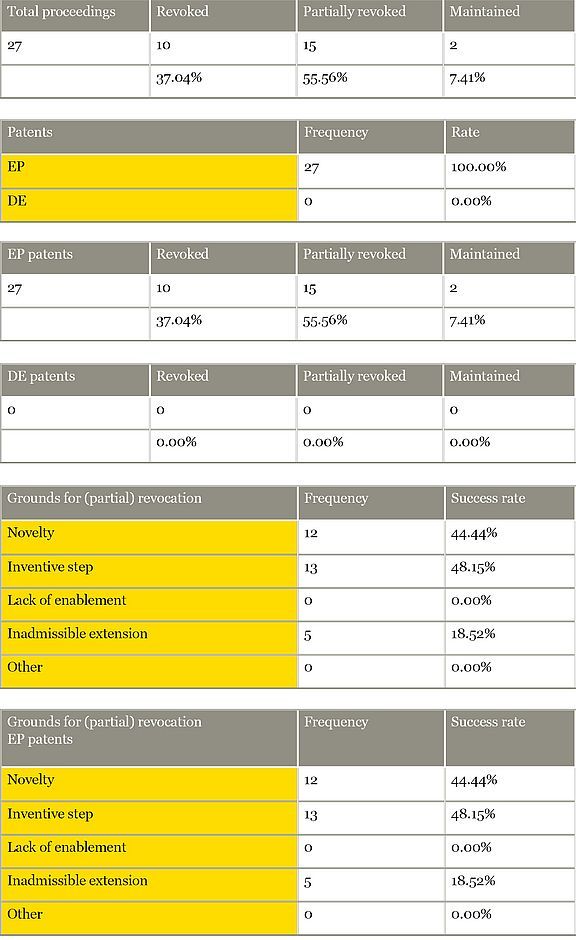
5. Overview of the figures for the 3rd Senate
a. Total figures for 2018-2020
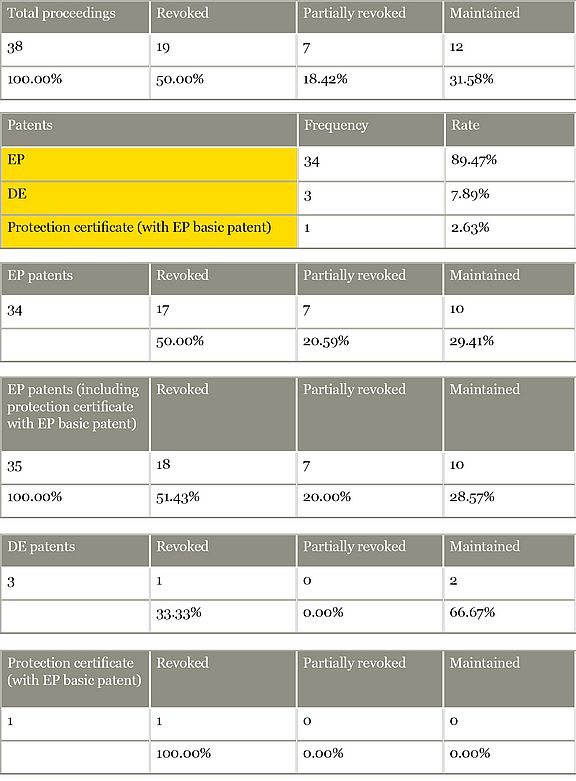
b. Figures relating to S/T patents

6. Overview of the figures for the 4th Senate
a. Total figures for 2018-2020

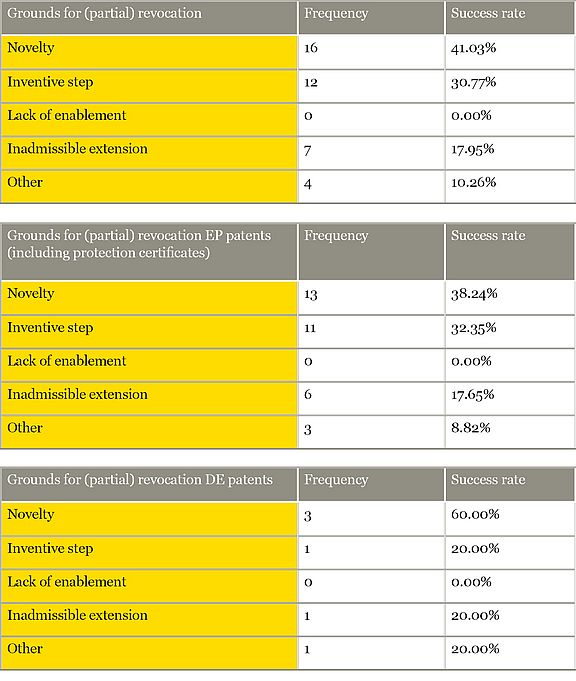
b. Figures relating to S/T patents
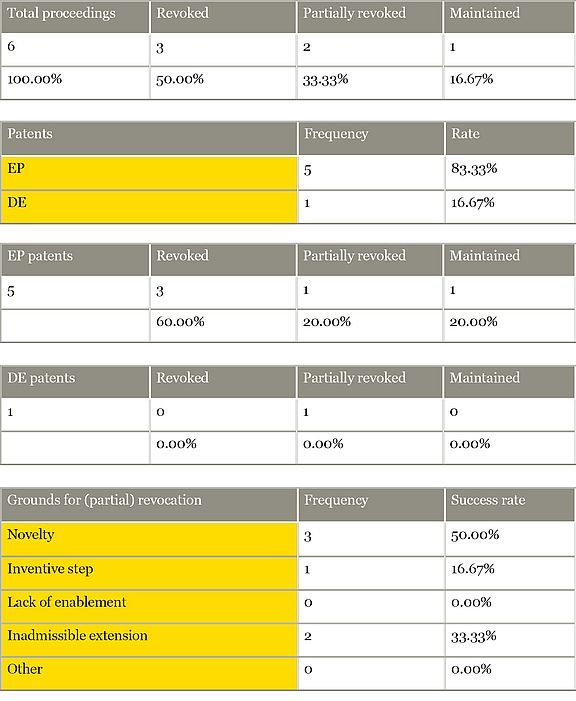
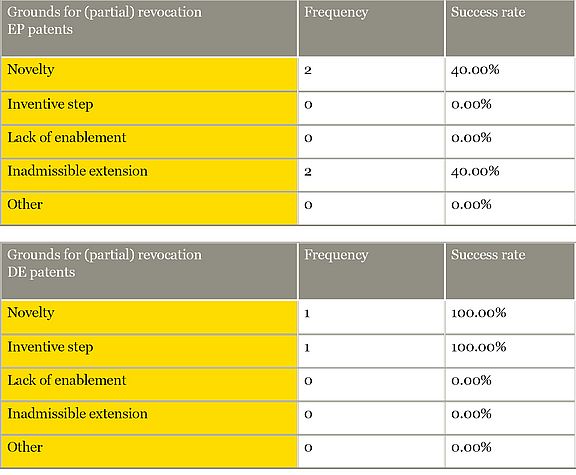
7. Overview of the figures for the 5th Senate
a. Total figures for 2018-2020

b. Figures relating to S/T patents
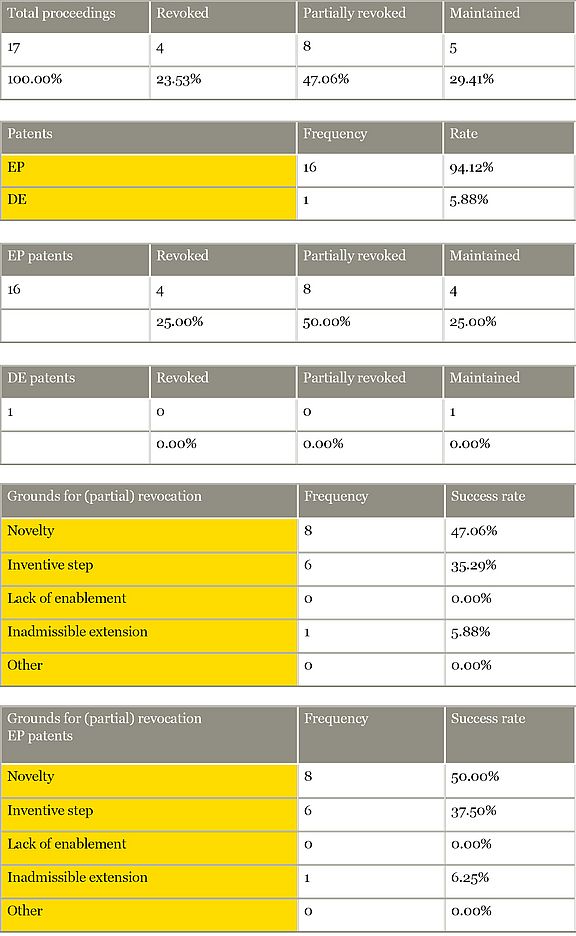
8. Overview of the figures for the 6th Senate
a. Total figures for 2018-2020
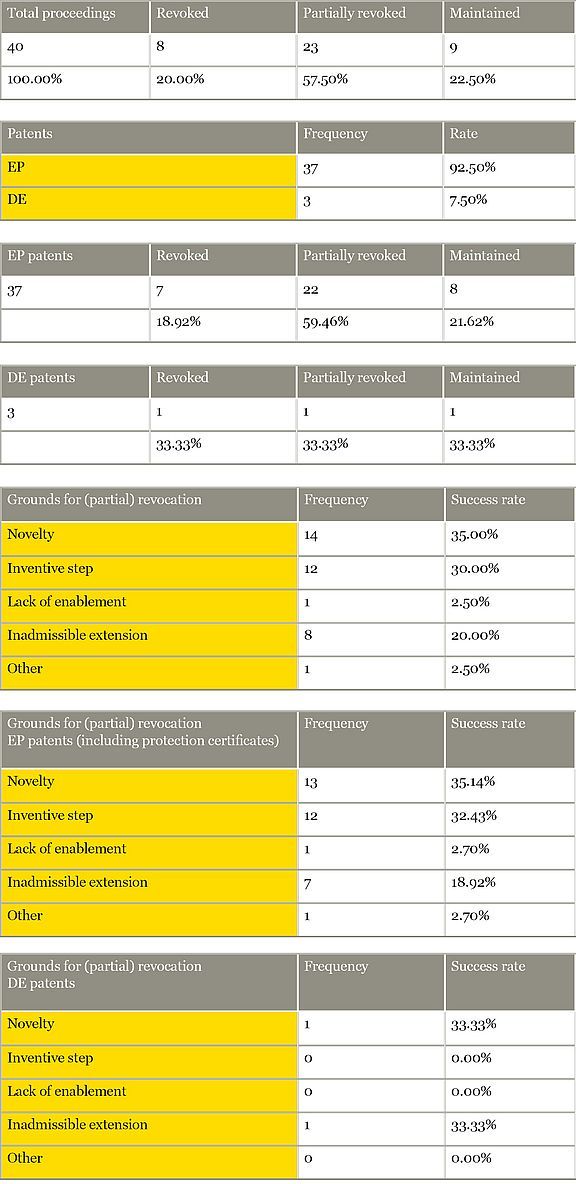
b. Figures relating to S/T patents
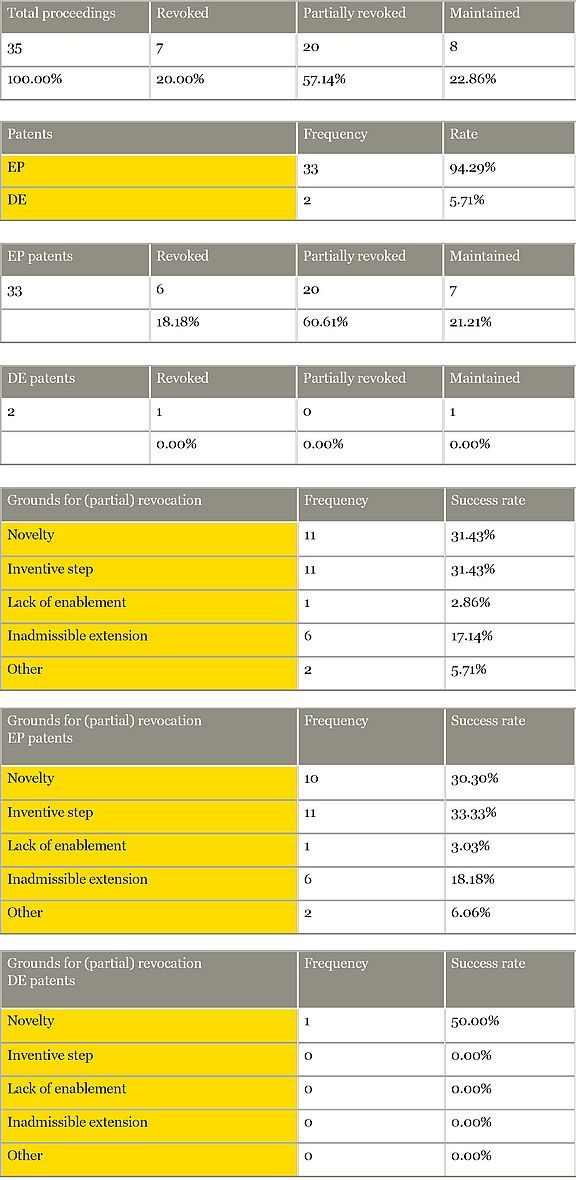
9. Overview of the figures for the 7th Senate
a. Total figures for 2018-2020
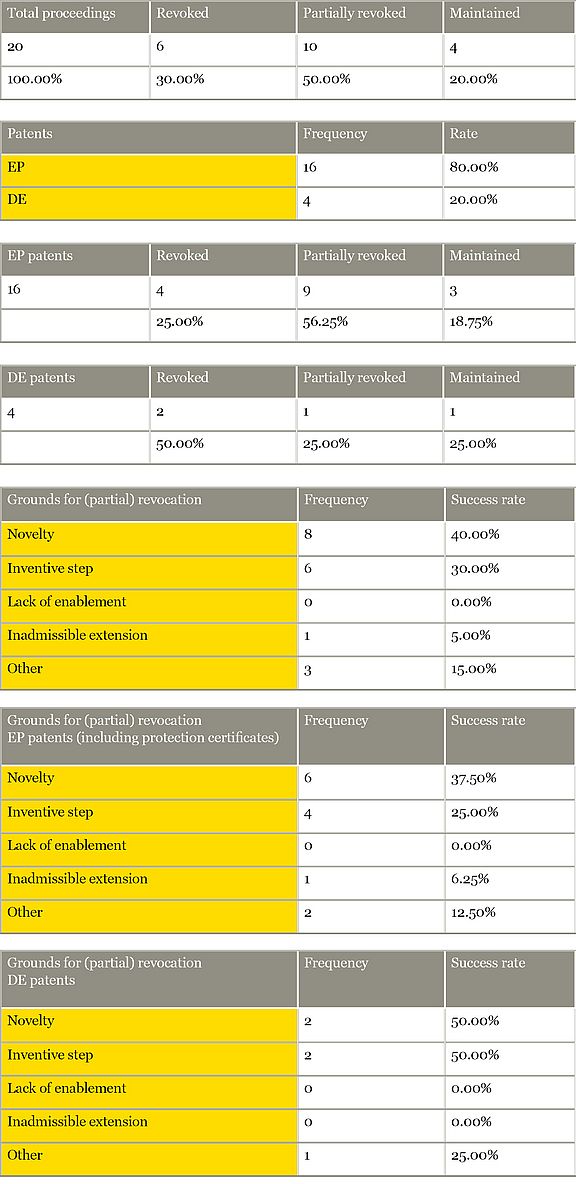
b. Figures relating to S/T patents
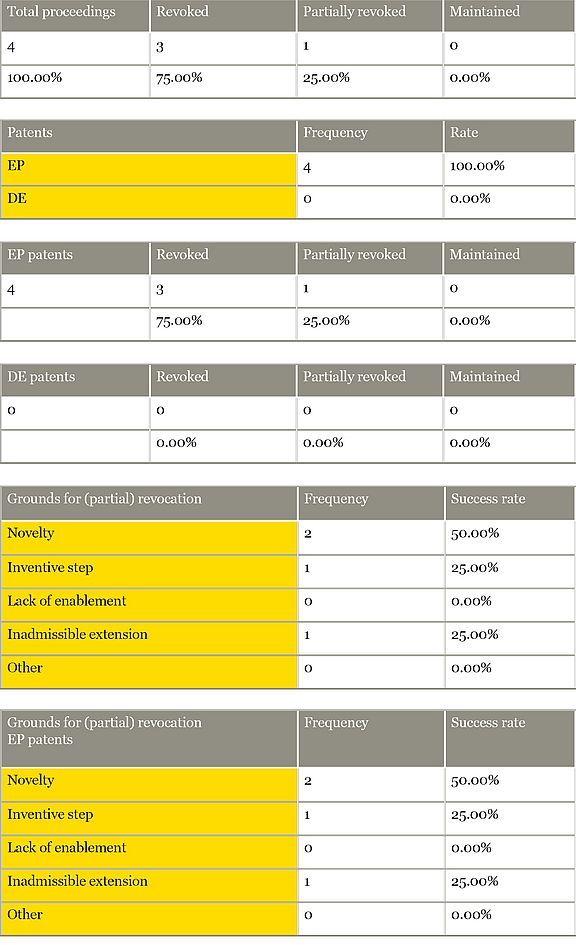
10. Statistics regarding the claim of "public prior use" before the German Federal Patent Court
In the present case, the claim of public prior use was only qualified as being “successful” where the patent attacked was (partially) revoked specifically on this basis.

Outcome of the proceedings in which the claim of public prior use was unsuccessful:
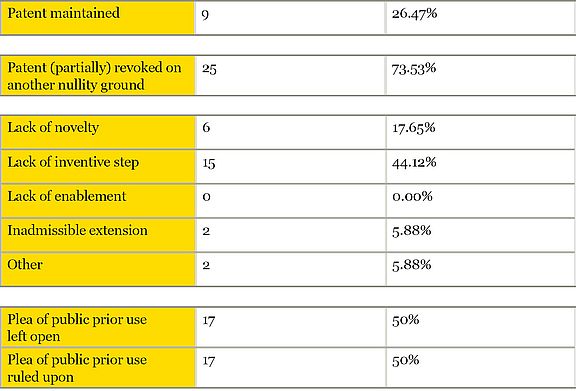
Reasons for the plea of public prior use asserted being unsuccessful:
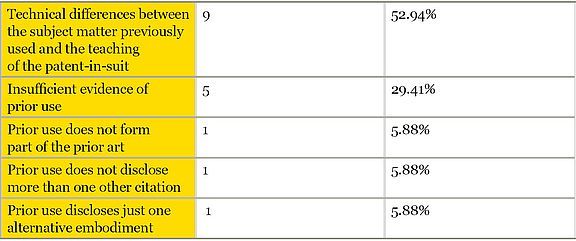
II. German Federal Court of Justice
1. Overview of the figures for the 10th Senate
a. Total figures for 2018–2020
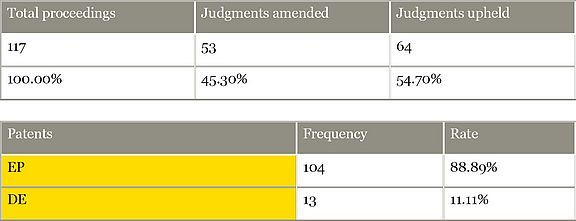
b. Figures relating to judgments upheld by the Court

c. Figures relating to amending judgments
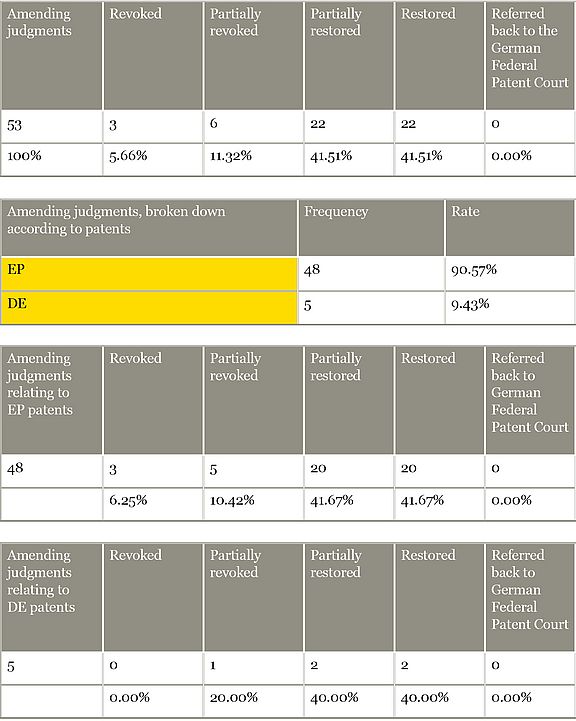
2. Figures relating to S/T patents
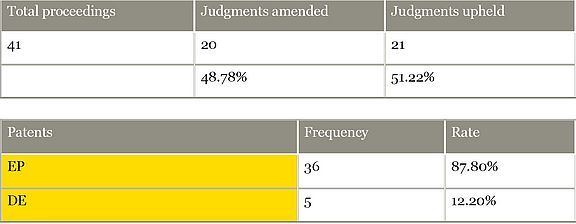
a. Figures for judgments upheld by the Court with regard to S/T patents
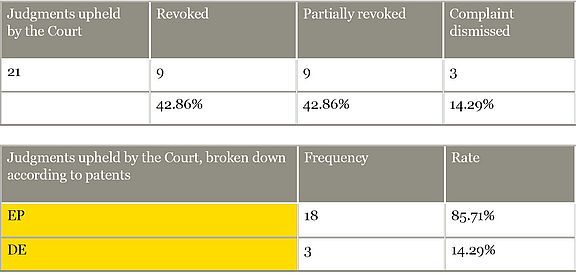
b. Figures for amending judgments relating to S/T patents
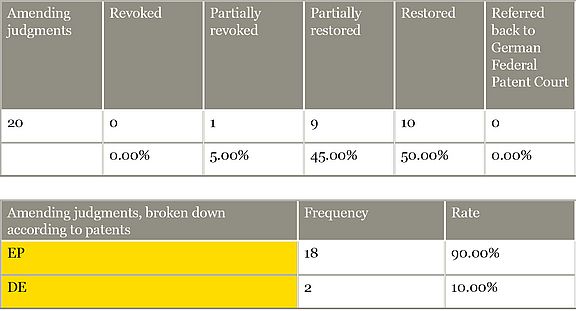
3. Statistics relating to the claim of “public prior use” before the German Federal Court of Justice
Note: In the present case, the claim of public prior use was only qualified as being “successful” where the patent attacked was (partially) revoked specifically on this basis.

Outcome of the proceedings in which the claim of public prior use was unsuccessful:
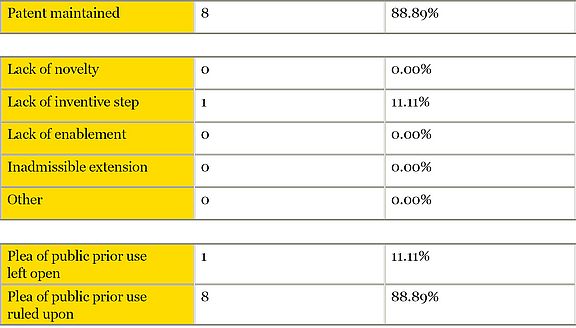
Reasons for the plea of public prior use asserted being unsuccessful:

C. Summary of the principal conclusions:
This raises the question as to the findings of the survey. The basic results can be summarized as follows:
- The revocation rate (i.e., cases in which patents were fully or partially revoked) is approximately 80.00% for all Senates of the German Federal Patent Court (for the period between 2010 and 2013 inclusive, the rate was 79.08%).
- The revocation rate is approximately 82.00% for the German Federal Patent Court with regard to S/T patents (for the period between 2010 and 2013 inclusive, the rate was 88.11%).
- The revocation rate is 74.60% for the German Federal Court of Justice in those cases in which it upheld the judgments of the lower court (for the period between 2010 and 2013 inclusive, the rate was 75.25%).
- The revocation rate is 58.49% for the German Federal Court of Justice in the case of amending judgments (however, for the period between 2010 and 2013 inclusive, the rate was 80.56%).
- The revocation rate is approximately 85.00% for the German Federal Court of Justice in cases relating to S/T patents where the said Court upheld the judgments of the lower court (for the period from 2010 to 2013 inclusive, the rate was 79.41 %).
- The revocation rate is approximately 50.00% for the German Federal Court of Justice in cases of amending judgments relating to S/T patents (for the period from 2010 to 2013 inclusive, the rate was 73.34 %).
- The German Federal Court of Justice upheld approximately 54% of the judgments of the German Federal Patent Court and amended approximately 46% of the judgments of the German Federal Patent Court (in the period between 2010 and 2013 inclusive, the German Federal Court of Justice upheld approximately 60% and amended approximately 40% of the judgments of the German Federal Patent Court). This reveals that almost half of all judgments in the nullity appeal proceedings are ultimately amended and, therefore, that nullity appeal proceedings are by no means without the prospect of success. This also reveals that approximately half of the judgments of the German Federal Patent Court are therefore not final and absolute.
- However, approximately 83% of the amending judgments of the German Federal Court of Justice are in favor of the patent proprietor (whereas, in the period between 2010 and 2013 inclusive, only approximately two thirds of the amending judgments were in favor of the patent proprietor).
- By far the main nullity ground before the German Federal Patent Court is still lack of patentability at almost 73%, followed by inadmissible extension at almost 10%, “other” at almost 6% and lack of enablement at less than 1% (in the period between 2010 and 2013 inclusive, the main nullity ground was also lack of patentability at approximately 75%, but followed by “other” at almost 12%, inadmissible extension at almost 11% and lack of enablement at approximately 2%).
- In 41 proceedings before the German Federal Patent Court, claims for nullity were brought based on public prior use. This amounts to a rate of 18.55% of all nullity proceedings in the period between 2018 and 2020. However, in almost 83% of cases, the patent was either maintained or revoked for another reason.
- In cases before the German Federal Court of Justice, however, claims for nullity based on public prior use were only brought in 11 nullity proceedings, which amounts to a rate of 9.48% of all nullity proceedings in the period examined. However, in just over 80% of cases, the patent was either maintained or revoked for another reason.
1) Müller-Stoy/Hess, Mitt. 2014, 439.
2) Higher Regional Court of Düsseldorf, GRUR-RR 2008, 329 – Olanzapin; GRUR-RR 2011, 81 – Harnkatheterset; Higher Regional Court of Karlsruhe, GRUR-RR 2015, 509 – Ausrüstungssatz; Higher Regional Court of Munich, GRUR 2020, 385 – Elektrische Anschlussklemme.
3) Regional Court of Munich I, decision dated January 19, 2021, docket number 21 O 16782/20 = GRUR-RS 2021, 301; for details of the division in the judges’ opinions: see notes in Kühnen, GRUR 2021, 466; Pichlmaier’s response, GRUR 2021, 557.
4) Müller-Stoy/Hess, Mitt. 2014, 439.
5) In the period between 2018 and 2020, this involved the Senates 1, 2, 3, 4, 5, 6, and 7.
6) All decisions were retrieved from the website of the German Federal Patent Court, https://www.bundespatentgericht.de. Upon inquiry, we were informed that the decisions collected include all decisions that the Senates intended to publish. A few decisions from 2020 are still to be included. As at July 22, 2021.
7) All decisions of the German Federal Court of Justice were retrieved from the latter’s website, https://www.bundesgerichtshof.de. As at July 22, 2021.
8) All patents in the IPC main classes G and H are subsumed under these.


